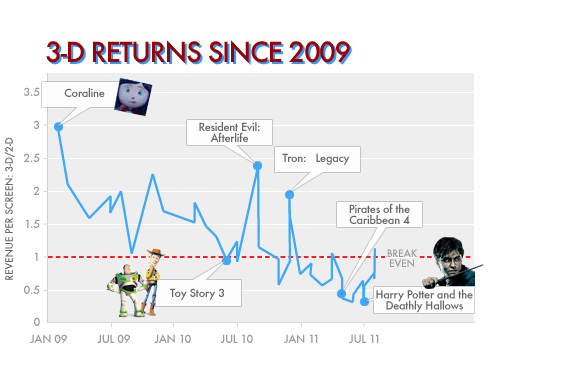?/?
Science
?:?
The state of the universe.Updated Thursday, Sept. 15, 2011, at 7:19 AM ET This time last year, there were whispers among film executives and industry-watchers that 3-D cinema had worked its way down a blind alley with its pockets full of cash. That summer, the format seemed like the answer to all of Hollywood's problems: shrinking ticket sales, video piracy, home-theater viewing. The studios had put out a run of record-smashing, premium-priced blockbusters: Avatar, Alice in Wonderland, How to Train Your Dragon, Clash of the Titans, Shrek Forever After, and Toy Story 3?a half-dozen 3-D movies that earned more than $2 billion in domestic sales. Yet by the end of August 2010, the future of cinema was starting to look unsteady on its feet. Box-office returns from the next wave of 3-D films were disappointing. The revival needed reviving.
This time last year, there were whispers among film executives and industry-watchers that 3-D cinema had worked its way down a blind alley with its pockets full of cash. That summer, the format seemed like the answer to all of Hollywood's problems: shrinking ticket sales, video piracy, home-theater viewing. The studios had put out a run of record-smashing, premium-priced blockbusters: Avatar, Alice in Wonderland, How to Train Your Dragon, Clash of the Titans, Shrek Forever After, and Toy Story 3?a half-dozen 3-D movies that earned more than $2 billion in domestic sales. Yet by the end of August 2010, the future of cinema was starting to look unsteady on its feet. Box-office returns from the next wave of 3-D films were disappointing. The revival needed reviving.
An analysis published in Slate last August showed that the patient might already have flat-lined. The profitability of 3-D cinema had dropped since the start of the vogue several years earlier, and more recent films were barely breaking even on their 3-D screenings. Now we've got another year's worth of data?12 months' more evidence that the medium is in peril. According to a New York Times business story from June, waning enthusiasm for 3-D has brought the vultures circling, with shares of DreamWorks Animation, the studio managed by Jeffrey "2-D films are going to be a thing of the past" Katzenberg, in free-fall. Shares of RealD, one of the big players in stereo projection technology, have also been in a tailspin, losing 70 percent of their value since May.
"Anyone would have realized he was dead, just one look at those staring eyes," says Grace Kelly's character in Dial M For Murder, the Hitchcock thriller that became one of the last mainstream 3-D features to be produced during an earlier cycle of boom and bust. By the time of that film's release in 1954, the first great fad for stereo cinema had perished without much ceremony. By all appearances, its 21st-century descendent has met a similar fate.
Identifying the victim is easy, though. The trick is to find the culprit. Like Dial M's Inspector Hubbard, it's time to make a careful accounting of the evidence, to follow the trail of box-office numbers to their bloody end. It's been a year since 3-D first began to stagger, and we finally have some clues about what might have caused its demise. Let's line up the suspects and verify their stories against the facts. Who killed 3-D?
First things first: Check the body. Is it still warm, or has it locked up in rigor mortis? Last year, our answer was based on a simple calculation: For every movie that's released in both 2-D and 3-D, how does the revenue from the two compare on a per-theater basis? (In other words: Which format brings in more money?) When Avatar opened in 2009, it earned about $15,800 for every theater that showed the film flat, and about $26,800 for every one that showed it in 3-D. It's not unreasonable to suggest that the owner of an old-fashioned theater might have increased her revenue by $11,000?or 70 percent?by upgrading her equipment and showing Avatar in 3-D.
For all the Avatar hype, this wasn't an exceptional figure. Pretty much all of the 3-D films released in 2009 and early 2010 were earning from 50 to 100 percent more money from 3-D than 2-D on a per-theater basis. (Some movies, like Monsters vs. Aliens and The Final Destination, more than doubled their income.) The first clear sign of danger came the weekend of June 18, 2010. Toy Story 3 opened with $110.3 million in ticket sales, making it one of the most successful films in history. Yet the Pixar movie's 3-D screenings contributed relatively little to its dazzling profits. Their per-theater revenue was at minus-5 percent compared to 2-D showings?the first time in recent history that 3-D had sunk below the break-even point on a film's first weekend. Six weeks later, Cats & Dogs: The Revenge of Kitty Galore opened with $12.3 million in total sales, and a 3-D "bonus" of minus-10 percent. The monster profits from 2009 had all but disappeared by the end of the summer.
The health of the medium has only worsened. The studios have released more than two dozen major 3-D features since Cats & Dogs. A couple of those?Resident Evil: Afterlife and Tron: Legacy?seemed to benefit from 3-D showings, but the rest did not. About three-quarters of the last year's films saw negative returns from 3-D, and many landed far below the breakeven point. The newest Harry Potter and Kung Fu Panda movies, plus Captain America and Green Lantern, saw revenue adjustments of around minus-65 percent. In other words, their screenings at 3-D theaters were making just one-third as much money as regular showings.
The updated graph below shows almost every major 3-D release since the beginning of 2009. The ratio of 3-D revenue to 2-D revenue per theater is shown on the Y-axis, and the dotted red line represents the break-even point. The trend that was beginning to take shape last summer has deepened in the last few months. (Data exclude any film that opened at fewer than 1,500 locations, and films with "3-D" in the title, which only a fool would see on a flat screen.)

It might seem premature to suggest that stereo cinema has passed away, given that Steven Spielberg's The Adventures of Tintin will come out this fall, along with a stereoscopic movie from Martin Scorsese and a 3-D stoner comedy with Harold and Kumar. (We've also got the looming juggernauts of Avatar 2 and Avatar 3, tentatively set for 2014 and 2015.) Still, the downward trend in 3-D revenue numbers is unlikely to reverse anytime soon. If the medium isn't dead, it's mortally wounded.
OK, Inspector Hubbard, so whom should we blame?
1. Greedy theater chains.
The first and most obvious culprit would be the theater chains, which responded to the revival's early success by ratcheting up the 3-D premium. In the spring of 2010, the Wall Street Journal reported that AMC, Regal, and other major exhibitors were about to raise their prices by 20 percent or more, in the hopes of inflating the bubble even bigger than it was after Avatar and Alice in Wonderland.
Like Slate on Facebook. Follow us on Twitter.
Source: http://www.rottentomatoes.com/m/1923575/news/1923575/
national grid carole lombard bieber bieber the hunger games movie the hunger games movie adele
No comments:
Post a Comment